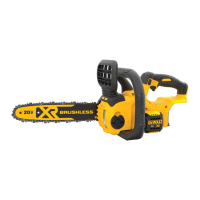ENGLISH
9
NOTE: In the event of kickback, your left hand will come in
contact with the front guard, pushing it forward, toward the
workpiece. This will stop thetool.
Fig. M
3
13
Testing The Chain Brake
Test the chain brake before every use to make sure it
operatescorrectly.
1. Place the tool on a flat, firm surface. Make sure the saw
chain
5
is clear of theground.
2. Grip the tool firmly with both hands and turn the chain
sawon.
3. Rotate your left hand forward around the front
handle
13
so the back of your hand comes in contact
with the Chain brake / front hand guard
3
and push it
forward, toward the workpiece. The saw chain should
stopimmediately.
NOTE: If saw does not stop immediately, stop use of tool
and bring it to a DeWALT service center nearestyou.
WARNING: Make sure to set chain brake
beforecutting.
Common Cutting Techniques (Fig.A, N–T)
Felling
The process of cutting down a tree. Be sure battery is fully
charged before felling a tree so you can finish on a single
charge. Do not fell trees in high windconditions.
WARNING: Felling can result in injury. It should only be
performed by a trainedperson.
• A retreat path should be planned and cleared as necessary
before cuts are started. The retreat path should extend
back and diagonally to the rear of the expected line of fall
(seeFig.N).
DIRECTION
OF
FALL
RETREAT
45°
TREE
Fig. N
45°
RETREAT
• Before felling is started, consider the natural lean of the
tree, the location of larger branches and the wind direction
to judge which way the tree will fall. Have wedges (wood,
plastic or aluminum) and a heavy mallet handy. Remove
dirt, stones, loose bark, nails, staples, and wire from the tree
where the felling cuts are to bemade.
• Notching Undercut - Make the notch 1/3 of the diameter
of the tree, perpendicular to the direction of the fall. Make
the lower horizontal notching cut first. This will help to
avoid pinching of either the saw chain or the guide bar
when the second notch cut is being made (see Fig.O).
• Felling Back Cut - Make the felling back cut at least
2"(51mm) higher than the horizontal notching cut. Keep
the felling back cut parallel to the horizontal notching cut.
Make the felling back cut so enough wood is left to act as
a hinge. The hinge wood keeps the tree from twisting and
falling in the wrong direction. Do not cut through the hinge
(seeFig.O).
• As the felling cut gets close to the hinge the tree should
begin to fall. If there is any chance that the tree may not fall
in the desired direction or it may rock back and bind the
saw chain, stop cutting before the felling cut is complete
and use wedges to open the cut and drop the tree along
the desired line of fall. When the tree begins to fall remove
the chain saw from the cut, stop the motor, put the chain
saw down, then use the retreat path planned. Be alert for
overhead limbs falling and watch yourfooting.
2" (51 mm)
DIRECTION OF FALL
2" (51 mm)
HINGE
NOTCH
FELLING BACK CUT
Fig. O
Limbing
Removing the branches from a fallen tree. When limbing,
leave larger lower limbs to support the log off the ground.
Remove the small limbs in one cut. Branches under tension
should be cut from the bottom of the branch towards the
top to avoid binding the chain saw as shown in Fig.P. Trim
limbs from opposite side keeping tree stem between you
and saw. Never make cuts with saw between your legs or
straddle the limb to becut.
Fig. P
Bucking
WARNING: Recommend that first time users should
practice cutting on a sawhorse.

